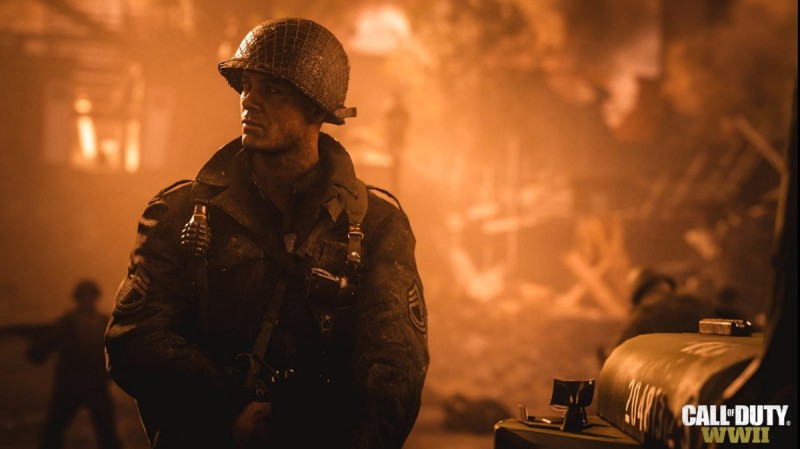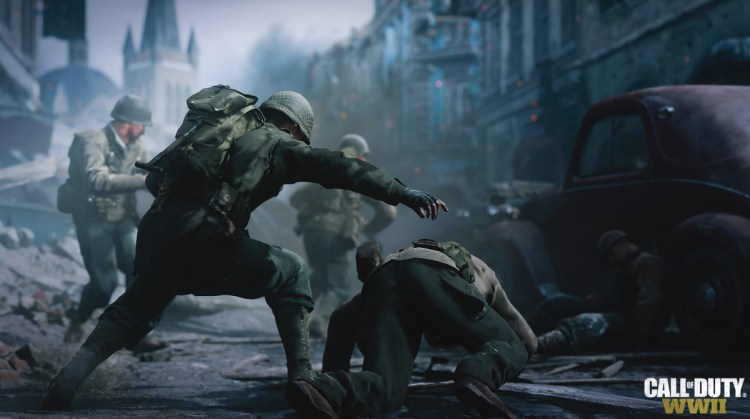
Above: Call of Duty: WWII has stark imagery.
GamesBeat: You did a lot of traveling, right? I think you said you went to the Reichstag?
Condrey: Yeah, we did. We’ve been all over the globe. We’ve been from Normandy to Gibraltar to Germany to Belgium. We’ve been across North America. We’ve sat in foxholes and Sherman tanks. We’ve driven half-tracks. You name it. We were in the Hurtgen forest at Hill 140.
Schofield: We set some of the combat in the woods. Guys are hiding behind trees, and it just didn’t feel right. There isn’t a lot of photos or film of combat in the woods. So we went out to these forests and we realized—the woods are full of trees fallen over. Guys were crawling and climbing all around. We went to places that you wouldn’t think we’d need to, but you really have to study some of this stuff to get what it was like. You don’t just have guys peeking their heads around trees. One soldier was telling me, if a German hid behind a tree I just put a bullet through the tree.
Condrey: We had this really remarkable trip just a couple of months ago. Europe was going through a pretty historic winter this last February. Glen and I were there, going from Luxembourg to Belgium up into Germany. There’s eight feet of snow in the ground, it’s zero degrees, and we’re standing in an original foxhole, the dug-out foxholes of 101st on the edge of Hürtgen Forest in the freezing cold. It gives you a profound respect for the conditions these battles happened in. It was powerful. We were out there in really high-end Tahoe ski gear, too, freezing to death. They were living in these holes. We’d run back to the van, huddle up, get some coffee.
June 5th: The AI Audit in NYC
Join us next week in NYC to engage with top executive leaders, delving into strategies for auditing AI models to ensure fairness, optimal performance, and ethical compliance across diverse organizations. Secure your attendance for this exclusive invite-only event.
Schofield: There’s still stuff there they carved into the trees. We found barbed wire still wrapped around the trees. And to see the hundreds of miles they put down the dragon’s teeth—here’s a crazy little story. We’re in the middle of nowhere. I’d swear we hadn’t seen a car in an hour. It’s snowing like crazy. Zero degrees. We pull over in these giant woods and there’s a little road. We stop and look around, looking at foxholes and stuff, and 10 minutes later we go back to see there’s someone by our car. We’re getting a parking ticket. “You’re blocking a fire road.” There’s four feet of snow!
Condrey: We saw Patton’s grave in Luxembourg. The list of places we’ve gone—this much, and we’ve only scratched the surface. The conflict was so massive, across so much of western Europe—both the history and just the physical battles—
Schofield: Have you ever been to Luxembourg?
GamesBeat: No, haven’t been.
Schofield: We hadn’t either, right? You wonder why the Germans didn’t just bounce in and take over Luxembourg. But you don’t realize until you get there that Luxembourg is mountainous. Crazy mountains. There’s no way you could get tanks through there. The Germans just left it alone. It was important for us to go to these places and realize things like that.
The interesting thing about Hurtgen Forest is it’s old growth. But mixed in, there’s a lot of new growth. So many trees were blown apart that we were seeing these big patches of 60-year-old trees mixed in with the huge 150-year-old ones.
Condrey: We stood by the first V2 rocket, which is really where the space age was invented, at that first launch site. We saw the internment camps outside Berlin. We really tried to go deep. And the deeper you go—through reading books and watching documentaries, going to museums as well–you pick up this profound sense of obligation to the story. We don’t want to trivialize it through our fictional version. We want to capture what it meant at the time. That’s where it becomes most personal to me.
Schofield: Not only that, but—remember when we were up in Bastogne? It was snowing there too. In Bastogne and other places they have monuments everywhere. We saw one monument after another to the Allies, thanking the Americans and thanking the other nations. We’d see tanks everywhere, where they just left them where they were and built a little park around it or whatever. We found one in the middle of nowhere, this giant Tiger tank that they just couldn’t move. I forget how many tons it was, but they couldn’t get it out of there, so they turned it into a monument. There are remnants of the war everywhere.
GamesBeat: Has the historian Marty Morgan been useful to you?
Condrey: Marty’s been phenomenal. He has a great history. You can look him up.
Schofield: He speaks all the different languages.
Condrey: He’s traveled throughout Europe and the Pacific doing academic tours. He’s the military historian for the WWII museum in Orleans. He was the military historian for Band of Brothers. He’s taught us so much.
Schofield: He doesn’t stop. It’s funny. We were seven or eight days in a van, the four of us, when we went on this one trip, and at some point I said, “Marty, I can’t take in anymore.” He’s so knowledgeable. What we’d do is just make sure that everything we did, it happened.
Condrey: It’s all based on real events. He’s still with us, by the way. I emailed him this morning looking for details about a certain regiment.
GamesBeat: Was there a process of pitching this upward to Activision?
Schofield: I have to say about Activision, they understand the creative motivation. They’re almost fanatical about us being passionate about the game we’re making. If they can sense we’re not passionate about it, they’ll say, “Okay, what is it?” It starts with Eric Hirshberg and some of those guys. They saw the passion we came back with and they were absolutely behind it. They wanted WWII anyway, but they didn’t want to try and force us, which I do appreciate. I’ve been in places where I’ve been forced to go there, and I don’t like it.
GamesBeat: It seems like the drift of history has been toward presenting something that’s less about nationalism and more about the individual experience.
Schofield: It’s a human war. It wasn’t just an American war.
GamesBeat: It’s interesting that you can use a game to tell a clearer version of history.
Condrey: And to tell a history that I think is fading from the eyes and minds of most of our generation. If you think about it, 75 years, that’s three generations. Grandfathers of today were born after the war. To make sure this story is told and heard—it’s time for us to retell it. That’s a huge honor.
GamesBeat: It seems like you guys found a mission in that and you stuck with it
Condrey: The reality of a three-year development cycle is you can’t expect to know, with 100 percent certainty, exactly where you’ll go between when you start and when you end. Nor should you. That’s the fastest way to make a derivative experience. You have to have time to fail and learn and explore and innovate and watch what’s happening with the fan reaction. We’ve certainly gone through that process, that the best creative companies go through, to get where we are today. But as far as wanting to deliver on an emotionally powerful narrative for WWII, a gritty and gripping depiction of the greatest conflict in human history, yeah. That was where we started two and a half years ago. It’s remarkable. It’s great to finally be able to talk about it.
Schofield: That was a real mouthful of adjectives. In a good way!


